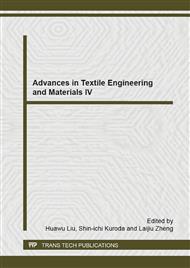p.144
p.151
p.160
p.164
p.168
p.173
p.181
p.186
p.191
The Optimum Choice of Fabric Based on Analytic Hierarchy Process
Abstract:
From the perspective of consumer’s different fabric demand, application operational research of analytic hierarchy process (AHP) for candidates of the fabric to choose the best. Dust coat fabric, for example, the optimal choice as the target layer of fabric, with fabric bending stiffness, elasticity and thickness, permeability index, thermal resistance as the criterion layer, according to the research of the typical multiple dust coat fabric for plan layer, dust coat fabrics of hierarchical analysis model is established, combining quantitative and qualitative indicators, structural optimization selection of fabrics of judgment matrix. Consumer’s demand determines the weights of criteria layer, candidate fabric corresponding criterion layer of the experimental data as a basis of criterion for solution layer weight. Using the matlab language to calculate and design the interface, so as to realize the intelligent optimization selection of fabrics.
Info:
Periodical:
Pages:
168-172
Citation:
Online since:
October 2014
Authors:
Price:
Сopyright:
© 2014 Trans Tech Publications Ltd. All Rights Reserved
Share:
Citation:


